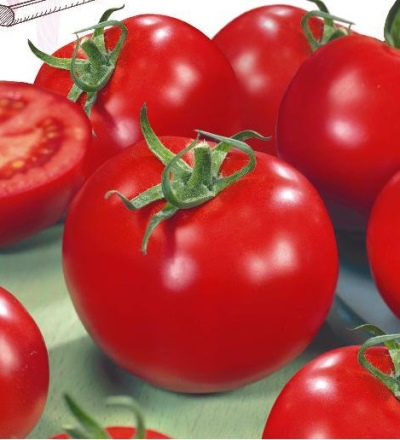
- Authors: Gavrish S.F., Morev V.V., Amcheslavskaya E.V., Volok O.A., LLC "Agrofirma Gavrish"
- Year of approval: 2002
- Category: grade
- Growth type: determinant
- Appointment: universal
- Ripening period: early
- Ripening time, days: 90-95
- Growing conditions: for open ground, for foil greenhouses, for balconies
- Bush size: undersized
- Bush height, cm: 60-70
Tomato Alaska is a very easy-to-care variety, suitable for breeding for novice gardeners. It is popular with summer residents for its taste. It makes excellent salads. Suitable for fresh consumption.
Breeding history
The variety was released quite recently, namely in 2002.
Brought to OOO Agrofirma Gavrish. The authors are Gavrish S.F., Morev V.V., Amcheslavskaya E.V., Volok O.A.
Description of the variety
The bush is undersized, but with a good development of stems, leaves on it are average. They are medium in size and have a slightly elongated rounded shape and dark green color. It blooms with simple inflorescences. The very first appears above the 8th sheet, and the subsequent ones at intervals of 1-2 sheets. The stalk of an Alaska tomato with a joint.
The main qualities of the fruit
Fruits of medium size, flat-round shape, during ripening change their color from green (unripe) to bright red (ripe). The pulp of tomatoes is juicy, covered on the outside with a skin that is fragile and prone to cracking. The weight of 1 tomato can reach 85-94 g.
Taste characteristics
Possesses excellent taste. Moderately sweet. But it is used only fresh. Poorly stored and not suitable for making blanks for the winter.
Ripening and fruiting
Quite early ripening and early variety of tomatoes. Reaches the fruiting date in early June. Ripens within 90-95 days after the first shoots.
Yield
According to its characteristics, it belongs to high-yielding varieties. Collect up to 9-11 kg / sq. m harvest. Fruiting up to 2 kg from one bush. Up to 5 fruits are formed on one brush.
The timing of planting seedlings and planting in the ground
With timely cultivation of this variety, the crop can be harvested as early as June. It is recommended to plant seedlings in the ground in May. Since the seeds need to be planted for seedlings in late March or early April. It takes about 60 days from seeds to finished seedlings. At this time, watering of not yet matured young shoots is carried out in a timely manner.

Growing tomato seedlings is an extremely important process, because it largely depends on whether the gardener will be able to harvest at all. All aspects must be taken into account, from seedbed preparation to planting in the ground.
Landing scheme
The seeds are first disinfected, then planted in separate small containers with prepared soil. Specialized tablets filled with peat are best suited. To get around the time it takes to adapt.
In addition to disinfection, several more steps are required to prepare the seeds before sowing into the soil.
Before treating the seeds with fungicides or hydrogen peroxide, the seeds are carefully selected (calibrated).
After processing, the seeds are soaked in special solutions to increase immunity to diseases and stimulate the growth of future plants.
An equally important stage is seed germination. To do this, all the seeds that have passed the previous stages are placed on a damp cloth, covered with it from above and laid in a warm place.The seeds are ready to plant when small white shoots have sprouted from them.
Then they are directly planted in the soil, to which not only fertilizers have been added, but also sufficiently moistened with water, to a depth of no more than 1 cm.
At the very beginning, before the emergence of seedlings, they create a warm temperature regime for the crops, and after the first stems they reduce it to +18 degrees.
After they have grown to a suitable size, in March they are planted from trays in the main soil. Which is specially prepared in advance by mixing it with fertilizers.
Before planting, the roots are watered with a little warm water to remove excess soil. And then they are planted in small depressions at a distance that is necessary to achieve a planting density of 6-7 plants per 1 m2. Then sprinkle with soil and lightly tamp. The distance between the rows of plants should be at least 40 cm.

Growing and care
In order for the tomato to bear fruit on time, and the quality of the fruit to be at the level, certain conditions must be observed. Namely: good illumination of plants, timely watering with water of the correct temperature. It is necessary to carry out a small pinching. But shaping the bush is not required. And also you need to feed the plants in the period before flowering and fruiting. Sometimes it is required to loosen the soil between seedlings.
It is necessary to take into account a small feature in the care: if this variety is grown on the balcony, and not in the open field, watering should be done much more often. And also to loosen potted plants.




A plant needs different micronutrients at each stage of growth. All fertilizers can be divided into two groups: mineral and organic. Folk remedies are often used: iodine, yeast, bird droppings, eggshells.
It is important to observe the rate and period of feeding. This also applies to folk remedies and organic fertilizers.
Disease and pest resistance
Quite resistant to diseases such as cladosporium and tobacco mosaic virus.


Growing regions
Suitable for growing in any conditions: on the balcony, in greenhouses and outdoors. Throughout our vast country. And in the Central and North-West and South-East regions. And also in the Far East.
Tomato Alaska is not suitable for growing on an industrial scale, as it is not at all suitable for processing. And it has poor keeping quality and transportability, which makes it an unsuitable variety for sale.

























































































